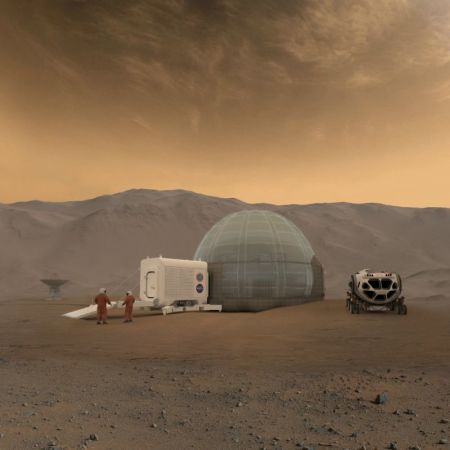NASA Reveals Stunning 'Ice Homes' to House Astronauts on Mars in Near Future
NASA plans to use the abundant ice on Mars to make homes for future residents on the red planet.

Sending people to Mars is a daunting task. Creating living spaces for them to reside in once they're there is even more challenging.
As NASA pushes towards its goal of sending humans to the red planet by the 2030s, it has unveiled an unorthodox concept for a housing structure to be used on Mars -- one that relies heavily on the use of ice.
The "Mars Ice Home", as it has been named, is a large inflatable dome-shaped structure. Its design is similar to that of an inner tube surrounded by a shell of water ice. Designed to a lightweight structure that can be transported and deployed with simple robotics, the residential building will make use of large amounts of ice in its design.
Scientists behind its design decided upon water ice as the principle material for two reasons: the first being that Mars holds massive reserves of ice frozen beneath its surface, and the second is that water, a hydrogen-rich material, is an excellent shielding material for galactic cosmic rays.
Galactic cosmic rays are one of the biggest risks of long stays on Mars. This high-energy radiation can easily pass through the skin thereby damaging cells or DNA which in turn increases risk of cancer or, at worst, acute radiation sickness, NASA said in a press release.
The significant danger presented by space radiation would suggest habitats buried under Mars' surface to be the most innocuous solution. However, the need for heavy robotic equipment to be transported from Earth and the human hardships of living underground make the idea unfeasible.
The "Ice Home" concept, created by a group of NASA experts along with passionate designers and architects from industry and academia at the agency's Langley Engineering Design Studio, tackles these problems in an innovative manner.
By using ice as a radiation shield and carbon dioxide, which is also readily available on Mars, to create an insulating layer, the structure will be translucent hence allowing sunlight to enter the living space. This makes for a more hospitable residential space than underground facilities for the astronomers who will likely spend months on the barren planet.
Another advantage is that the water in the Ice Home could potentially be converted to rocket fuel to be used by the Mars Ascent Vehicle (MAV), which is what Matt Damon uses to escape the planet at the end of 'The Martian'.
The key constraint faced by this concept is the amount of water that can be extracted from Mars. Experts indicated that it would be possible to fill the habitat with water at the rate of 35.3 cubic feet per day which would allow the Ice Home to be completely filled in 400 days.
Kevin Kempton from NASA's Langley Research Center and head of the project, is taking the challenges in his stride, keeping in mind the significance of his team's work.
"It's important for astronauts to have something to look forward to when they arrive on the Red Planet," Kempton said. "After months of travel in space, when you first arrive at Mars and your new home is ready for you to move in, it will be a great day."





















